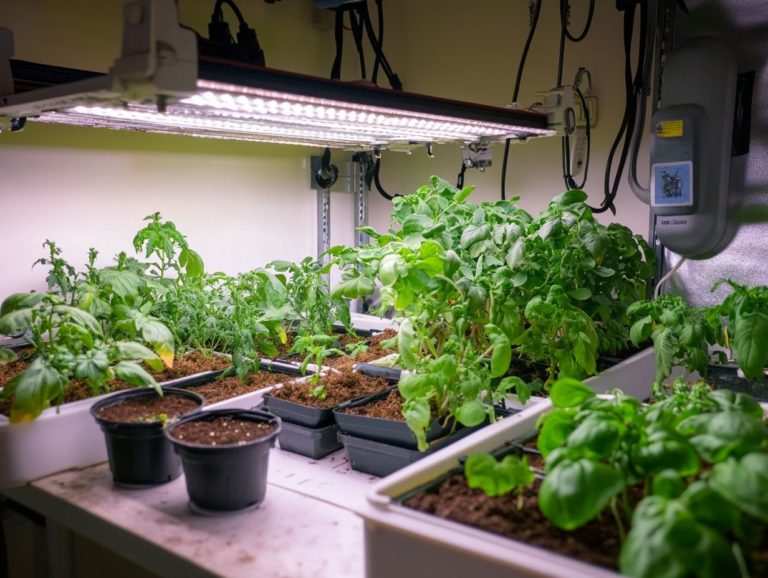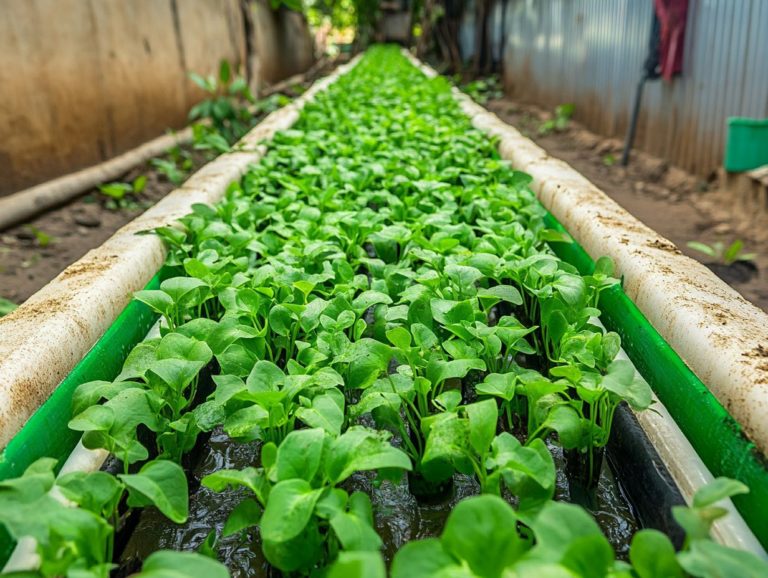Hydroponic Systems: Myths and Facts Explained
Hydroponics systems are revolutionizing the way you approach plant cultivation, presenting innovative solutions for urban gardeners and large-scale farmers alike.
This article delves into the essence of hydroponics, exploring its various types and dispelling the myths that often cloud your understanding of its benefits.
You ll discover the advantages that hydroponics offers both plants and growers, confront common challenges, and find practical steps to embark on your journey in this fascinating field.
Whether you re a curious novice or a seasoned grower, there s valuable insight here that caters to your needs.
Contents
- Key Takeaways:
- What is Hydroponic System?
- Myths Surrounding Hydroponic Systems
- Benefits of Hydroponic Systems
- Challenges of Hydroponic Systems
- How to Get Started with Hydroponic Systems
- Frequently Asked Questions
- 1. What is a hydroponic system and how does it work?
- 2. Is it true that hydroponic systems are only suitable for small plants or herbs?
- 3. Do hydroponic systems require a lot of maintenance and specialized knowledge?
- 4. Are hydroponic systems more expensive than traditional soil-based gardening?
- 5. Can a hydroponic system be used to grow organic produce?
- 6. Is it true that hydroponic systems eliminate the risk of pests and diseases?
Key Takeaways:

- Hydroponic systems allow you to grow plants without soil, using water and nutrients instead.
- While many myths surround hydroponic systems, they can be debunked with the right knowledge.
- Discover the amazing benefits of hydroponic systems that can boost your plants and your gardening game!
What is Hydroponic System?
Hydroponics is an exciting way to grow plants without soil. Instead, it uses water mixed with nutrients, making it a smart choice for modern farming.
This technique helps tackle food shortages, especially in cities. With hydroponics, you can cultivate a variety of crops in controlled spaces, leading to faster growth and bigger harvests.
By addressing critical issues such as food insecurity, particularly in urban areas where traditional agriculture may not thrive, hydroponics allows you to take charge of your agricultural endeavors. Nutrient acquisition can enhance plant growth significantly, as nutrients are delivered directly to the roots in various hydroponic systems.
You ll experience accelerated growth rates and significantly higher yields compared to traditional soil gardening.
Explanation and Types of Hydroponic Systems
There are several types of hydroponic systems, each crafted to meet different growing needs and environments. You might encounter methods like a system where a thin layer of nutrient solution flows over the roots, which is great for beginners, alongside Deep Water Culture and Aeroponics, which maximizes space efficiency.
Understanding these systems will help you choose the most suitable method for achieving your desired crop yield. The Nutrient Film Technique allows a thin film of nutrient solution to flow over the plant roots, ensuring they receive consistent moisture and nutrients, which significantly enhances growth rates.
In contrast, Deep Water Culture keeps the plant roots submerged in oxygen-rich nutrient solutions that provide optimal nutrition, promoting vigorous growth and enabling quicker harvesting cycles. Aeroponics, on the other hand, employs a misting system to deliver nutrient solutions directly to the roots, making it exceptionally efficient, especially in confined spaces. To debunk any misconceptions, you might want to explore common hydroponic gardening myths.
Each of these hydroponic systems presents unique benefits and is tailored for different applications, from small-scale home gardens to expansive commercial operations, all while relying on nutrient solutions and occasionally incorporating specific growing media. For those looking to delve deeper, understanding the basics of hydroponic systems can be invaluable. Rockwool is a favored growing media for many hydroponic systems, Perlite also serves as an effective medium, and Clay Pellets can provide excellent drainage and aeration.
Myths Surrounding Hydroponic Systems
Hydroponics often comes with a host of myths that can cloud your understanding of its effectiveness compared to traditional soil gardening, especially in discussions about food insecurity and sustainable agriculture practices essential for modern farmers.
It s essential to sift through these misconceptions to truly grasp the potential that hydroponics holds in addressing these pressing issues.
Debunking Common Misconceptions

One common misconception is that hydroponic gardens allow for efficient use of space but demand significantly more maintenance than traditional gardening methods. This concern is often unfounded and can lead to unwarranted worries about crop failure.
In truth, once properly set up, hydroponic systems can operate with minimal daily input. Unlike soil gardening, which requires relentless weeding, soil conditioning, and pest management, hydroponic systems use water that has the nutrients plants need to deliver essential elements directly to your plants.
Plants grown hydroponically can absorb nutrients more efficiently, resulting in faster growth and potentially higher yields. To understand how this works, check out the science behind hydroponic systems. Automated systems are available that monitor pH levels, nutrient concentrations, and water quality, significantly reducing the labor required for routine checks.
When comparing overall efficiency and care required, it’s clear that hydroponic gardening can often outshine traditional methods, making it a compelling and attractive alternative for urban and limited-space gardening.
Benefits of Hydroponic Systems
Hydroponic systems offer a wealth of advantages that elevate them as a compelling alternative to traditional agriculture. They play a pivotal role in promoting sustainable farming practices and enhance plant growth by optimizing nutrient delivery.
Advantages for Plants and Growers
One primary advantage for you as a grower is the direct access hydroponic systems provide to essential nutrients, which enhances plant nutrition and fosters healthier root systems.
This direct nutrient delivery accelerates growth rates and increases yields, while also significantly reducing the risk of plant diseases by eliminating waterlogged soil conditions.
Hydroponic setups maximize space efficiency, allowing for vertical farming and the opportunity to cultivate crops in urban environments where land is scarce.
These systems can adapt to various settings, from indoor gardens to greenhouses, ensuring your plants receive optimal conditions regardless of external weather. This adaptability bolsters overall plant health and enables you to produce high-quality crops year-round, fundamentally transforming agricultural practices.
Challenges of Hydroponic Systems
While hydroponic systems offer numerous advantages, you might face challenges that need your immediate attention. Addressing these issues is crucial to prevent crop failure and ensure your plants acquire the necessary nutrients.
Obstacles and How to Overcome Them

You might encounter various challenges related to nutrient solutions, water management, and the grow room environment. If not addressed, these issues can lead to crop failure.
Navigating nutrient solution imbalances can feel overwhelming. For instance, an excess of nitrogen may result in lush foliage but compromise fruit production. Regular testing is essential to maintain optimal nutrient levels.
Water management is critical for root health and presents challenges, such as nutrient runoff and pH fluctuations. Implementing a recirculating system can significantly reduce these concerns, ensuring your plants receive a consistent nutrient supply. For those interested in innovative solutions, exploring hydroponic systems: the future of food production can provide valuable insights.
Environmental factors like temperature and humidity require your attention, as they can profoundly impact plant growth. Using tools like timers and sensors can streamline adjustments, creating a more controlled and productive hydroponic environment.
How to Get Started with Hydroponic Systems
Embarking on your hydroponic journey is an exciting venture that invites you to establish your very own hydroponic garden. You’ll explore the fundamentals of plant growth and choose the ideal hydroponic fertilizer, paving the way for your success.
Steps for Setting Up and Maintaining a System
Setting up and maintaining a hydroponic system requires careful planning. Start by selecting suitable growing media and a well-balanced nutrient solution to ensure optimal plant health.
To embark on this journey, assess the various types of hydroponic systems available, such as deep water culture, nutrient film technique, or aeroponics. Each option has unique advantages tailored to different plants.
After settling on the system that aligns with your goals, prepare the growing media. Whether it is rock wool or coconut coir, ensure its compatibility with your chosen hydroponic approach.
With the media ready, establish a nutrient solution designed to meet your plants’ needs. This solution provides essential minerals and vitamins for robust growth.
Regularly monitor pH levels and nutrient levels. This practice allows you to maintain an ideal growing environment and nurture healthy crops throughout their lifecycle.
Frequently Asked Questions
1. What is a hydroponic system and how does it work?

A hydroponic system is a method of growing plants without soil. Instead, plants grow in a water-based solution rich in nutrients, allowing their roots to absorb what they need to thrive.
2. Is it true that hydroponic systems are only suitable for small plants or herbs?
No, this is a common myth. Hydroponic systems can grow a wide variety of plants, from small herbs to large fruits and vegetables.
In fact, some plants like tomatoes and cucumbers thrive in hydroponic systems due to the optimal conditions they provide.
3. Do hydroponic systems require a lot of maintenance and specialized knowledge?
While there is a learning curve when setting up a hydroponic system, it does not require extensive knowledge or constant maintenance.
Once set up, it only needs periodic monitoring and adjustments to keep nutrients balanced.
4. Are hydroponic systems more expensive than traditional soil-based gardening?
This is a common misconception. While initial setup costs may be higher, the long-term savings on water and fertilizer make hydroponic systems more cost-effective.
The controlled environment of a hydroponic system leads to higher yields and faster growth, ultimately saving money on produce.
5. Can a hydroponic system be used to grow organic produce?
Yes, it is possible to grow organic produce using a hydroponic system. However, certain systems using synthetic fertilizers may not be considered organic.
Research and carefully select organic-certified nutrients and systems for best results.
6. Is it true that hydroponic systems eliminate the risk of pests and diseases?
While hydroponic systems minimize the risk of pests and diseases, they are not completely immune.
The controlled environment makes it easier to manage these issues, but proper hygiene and preventative measures should still be taken.






